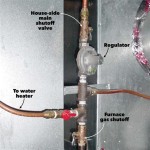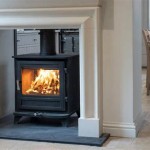Open Log Fireplace: A Timeless Source of Warmth and Ambiance
The open log fireplace, a traditional architectural feature, continues to hold a prominent place in residential design despite the advent of modern heating systems. Its appeal stems from a combination of functional warmth, aesthetic charm, and a primal connection to the elemental nature of fire. This article explores the key components, considerations, and benefits associated with owning and maintaining an open log fireplace.
The basic design of an open log fireplace has remained relatively consistent for centuries. It fundamentally consists of a firebox, a hearth, a damper, and a chimney flue. The firebox is the cavity where the fire is built, typically constructed of fire-resistant materials such as firebrick to withstand the intense heat. The hearth, extending outwards from the firebox, serves as a safety zone, preventing embers from igniting nearby flooring.
The damper, located above the firebox, controls airflow through the chimney. When open, it allows combustion gases to escape. When closed, it prevents drafts and heat loss from the home when the fireplace is not in use. The chimney flue is the vertical passage that carries smoke and gases away from the firebox to the outside atmosphere. Proper flue sizing is critical for efficient drafting and the prevention of dangerous backdrafts into the living space.
Fuel Selection and Combustion
The choice of fuel significantly impacts the efficiency and safety of an open log fireplace. Seasoned hardwood is generally considered the optimal fuel source. "Seasoned" refers to wood that has been properly dried for at least six months, ideally a year or more. This drying process reduces the moisture content, leading to cleaner, more efficient combustion, and less creosote buildup in the chimney. Common hardwood species used for firewood include oak, maple, ash, and birch. Softwoods, such as pine and fir, burn more quickly and produce more smoke and creosote, making them less desirable for open log fireplaces.
The combustion process in a fireplace relies on the principles of the fire triangle: heat, fuel, and oxygen. Efficient combustion requires an adequate supply of all three elements. The arrangement of logs within the firebox and the use of kindling and tinder are crucial for initiating and sustaining a fire. Logs should be stacked in a manner that allows for sufficient airflow around them. Smaller pieces of kindling ignite more readily, providing the initial heat necessary to ignite the larger logs. Tinder, such as paper or dry leaves, provides the initial flame to ignite the kindling.
Proper ventilation is essential for safe and efficient combustion. A lack of oxygen can lead to incomplete combustion, resulting in excessive smoke and the production of carbon monoxide, a colorless, odorless, and potentially deadly gas. A properly functioning chimney draft provides the necessary oxygen to the fire and removes combustion byproducts from the living space. Conversely, excessive draft can cause the fire to burn too quickly, wasting fuel and potentially overheating the chimney.
Safety Considerations for Open Log Fireplaces
Open log fireplaces, while aesthetically pleasing and comforting, present inherent safety risks that must be addressed rigorously. These risks include the potential for fire hazards, carbon monoxide poisoning, and respiratory irritation. Regular maintenance, adherence to safety protocols, and the installation of safety devices are crucial for mitigating these risks.
A primary safety concern is the risk of fire spreading beyond the firebox. Embers can escape from the fireplace and ignite nearby combustible materials, such as rugs, furniture, or drapes. A properly sized hearth extending sufficiently from the firebox is essential for providing a safety zone. The use of a fireplace screen is also highly recommended to contain sparks and embers. This screen should be constructed of sturdy metal mesh and should completely cover the fireplace opening.
Carbon monoxide poisoning is a serious hazard associated with incomplete combustion in fireplaces. Carbon monoxide detectors should be installed in the home, particularly near sleeping areas. These detectors provide an early warning of elevated carbon monoxide levels, allowing occupants to evacuate the premises and seek medical attention. Regular inspection and maintenance of the chimney are essential for ensuring proper drafting and preventing carbon monoxide from entering the living space.
The smoke and particulate matter produced by open log fireplaces can irritate the respiratory system, particularly in individuals with pre-existing respiratory conditions such as asthma or allergies. Proper ventilation and the use of seasoned firewood can help to minimize smoke production. Air purifiers equipped with HEPA filters can also help to remove particulate matter from the air, improving indoor air quality.
Maintenance and Efficiency Optimization
Regular maintenance is essential for ensuring the safe and efficient operation of an open log fireplace. This maintenance includes chimney sweeping, damper inspection, and firebox cleaning. Neglecting these tasks can lead to creosote buildup, chimney blockages, and increased fire risk.
Chimney sweeping involves the removal of creosote, a flammable residue that accumulates on the inner walls of the chimney flue. Creosote is a byproduct of incomplete combustion and can ignite, causing a dangerous chimney fire. The frequency of chimney sweeping depends on the frequency of fireplace use and the type of fuel burned. A qualified chimney sweep should inspect the chimney annually and recommend a cleaning schedule based on the specific conditions.
The damper should be inspected regularly to ensure that it is functioning properly. A damaged or improperly sealed damper can allow drafts to enter the home when the fireplace is not in use, increasing heating costs. A malfunctioning damper can also restrict airflow during combustion, leading to incomplete combustion and increased smoke production. The damper should be cleaned and lubricated as needed to ensure smooth operation.
The firebox should be cleaned regularly to remove ashes and debris. Ashes can accumulate in the firebox, reducing its capacity and hindering airflow. A shovel and brush can be used to remove ashes, which should be disposed of in a metal container. The firebox should also be inspected for cracks or damage, which should be repaired promptly to prevent further deterioration.
Several strategies can be employed to optimize the efficiency of an open log fireplace. These include using well-seasoned firewood, building a hot fire quickly, and closing the damper when the fireplace is not in use. Using seasoned firewood minimizes smoke production and maximizes heat output. Building a hot fire quickly reduces the amount of time that the fireplace is operating in an inefficient mode. Closing the damper when the fireplace is not in use prevents drafts and heat loss from the home.
Alternatives and Enhancements
While open log fireplaces offer undeniable aesthetic appeal, their energy efficiency is relatively low compared to modern heating systems. Several alternatives and enhancements can improve the efficiency and environmental impact of open fireplaces. These include fireplace inserts, glass doors, and catalytic combustors.
Fireplace inserts are self-contained heating units that are installed inside the existing firebox. These inserts typically burn wood, gas, or pellets and are significantly more efficient than open fireplaces. They often include features such as blowers and thermostats, allowing for precise temperature control. Fireplace inserts can significantly reduce heat loss and improve the overall heating efficiency of the fireplace.
Glass doors can be installed over the fireplace opening to reduce heat loss and improve safety. Glass doors prevent drafts from entering the home when the fireplace is not in use and help to contain sparks and embers during combustion. They also allow for viewing of the fire, preserving the aesthetic appeal of the open fireplace.
Catalytic combustors are devices that are installed in the chimney flue to reduce smoke emissions and improve combustion efficiency. These combustors use a catalyst to promote the oxidation of unburned gases and particulate matter, resulting in cleaner emissions. Catalytic combustors can significantly reduce air pollution and improve the overall environmental impact of the fireplace.

Open Fires V Wood Burning Stoves The Grate Debate Country Life

Wood Burner Vs Open Fire Bowland Stoves

How To Improve The Efficiency And Heat Output Of Your Open Fireplace Direct Fireplaces

Practical Advice For Open Wood Fireplace From Camelot Real Fires

Open Fire Basket Sweep Casa Stoves London

Practical Advice For Open Wood Fireplace From Camelot Real Fires

Log Burners Open Fires Love Logs

How To Open Up A Fireplace Direct Fireplaces

How To Light A Cosy Log Fire Toad Hall Cottages Blog

Old Fashioned Open Log Fireplace In With Flames And Sparks Stock Photo Adobe
Related Posts








